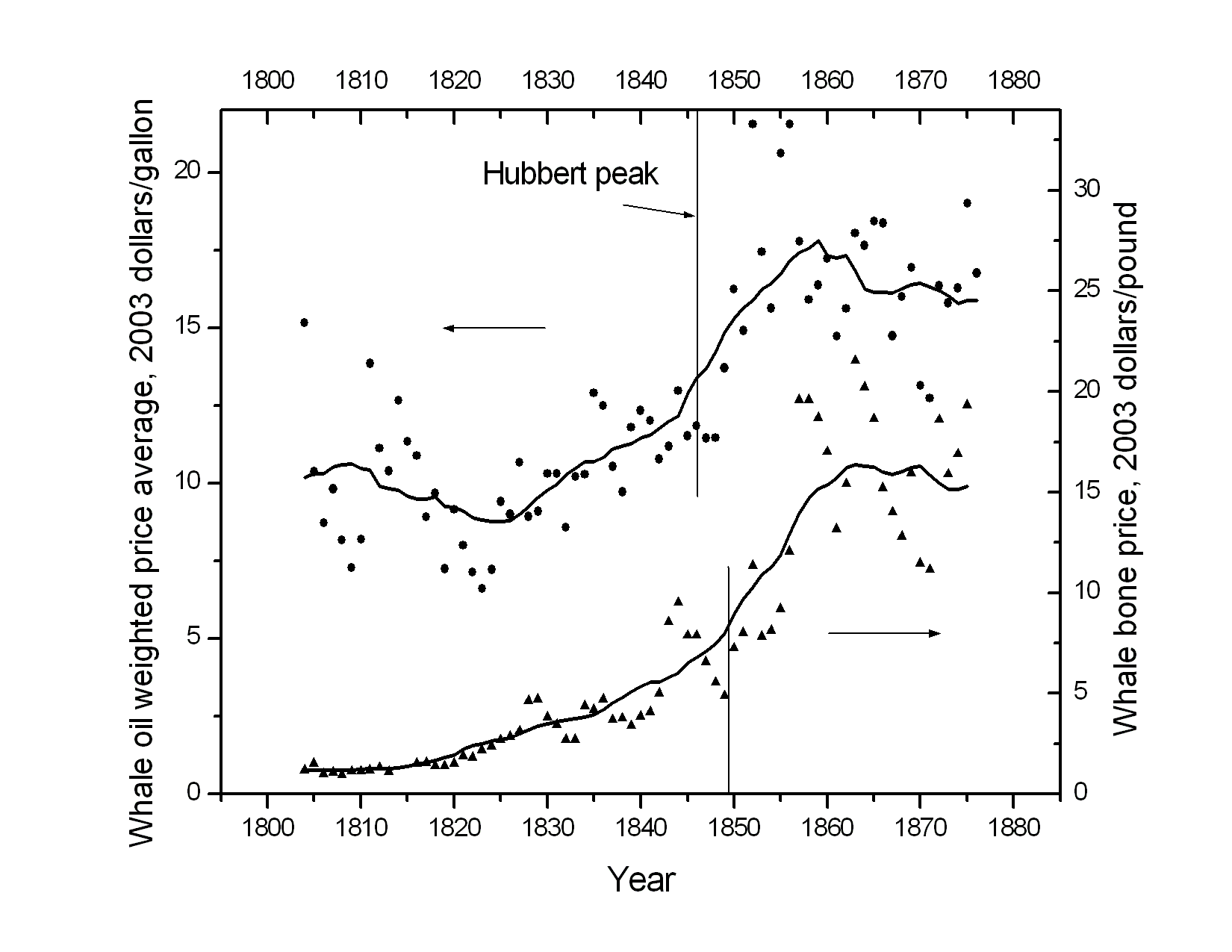The present collapse of oil prices finds some parallel with a much older case: that of whale oil and “whale bone” in the 19th century; both being commodities which suffered depletion and a production peak. Note the very strong oscillations that occur at around the peak and seem to increase with time. Note also how the average price levels stabilized at some point: there is a limit to what people are willing to pay for any commodity. It was true for whale oil, it is true for crude oil. Hence, it is likely that oil prices will keep increasing for a while, but then will stabilize, at least as an average. Image from a 2008 post by Ugo Bardi on “The Oil Drum”
In 2008, I published a post on “The Oil Drum” (reproduced below) where I tried to predict the behavior of crude oil prices on the basis of a comparison with the historical case of whale oil. In the first half of the 19th century, whale oil was an important commodity used mainly as fuel for oil lamps. It was, theoretically, a renewable resource, but whales were killed so fast that they didn’t have enough time to reproduce and reconstitute their numbers. So, whale oil behaved as if it was a nonrenewable resource: it suffered of depletion. As I reported in the post, its production showed a symmetrical, bell shaped curve and a clear “Hubbert peak.”
In 2008, we were nearly at the end of a phase of rapid growth of oil prices; a trend that – at the time – seemed to be unstoppable. But I made the point that prices could not keep rising forever. I stated that:
“…the historical data for whaling tell us that an exponential rise of the prices is not the only feature of the post-peak market. The prominent feature is, rather, the presence of very strong price oscillations. We can attribute these oscillations to a general characteristic of systems dominated by feedback and time delays. Prices are supposed to mediate between offer and demand, but tend to overcorrect on one side or another. The result is a succession of demand destruction (high prices) and offer destruction (low prices)”
It seems that this is exactly what we are seeing for crude oil: very strong price oscillations. Just a few months after that my post was published, oil prices did indeed collapse. Today, we are seeing something similar and we tend to interpret the present downward cycle as the result of strategic choices or conspiracies, but this is mostly an illusion (the illusion of control). Rather, it seems that the market cannot regulate production as a function of progressive depletion without these cycles of demand destruction and offer destruction which eventually lead to a decline in production. Comparing with the behavior of whale oil prices, we see that in the future we may expect further oscillation and an overall trend of growth in the years after the production peak. However, prices should eventually stabilize, at least on the average.
In this comparison, we need to take into account that there is a fundamental difference to take into account when comparing the case of whale oil and that of crude oil. Whereas whale oil was smoothly replaced by a cheaper and more abundant resource (kerosene), no such possibility is in sight for crude oil. Eventually, however, what changes is just how much people are willing to pay for something. People were still buying whale oil when kerosene was dominating the market; they were willing to pay a moderate premium for a product that was perceived as of superior quality. In the case of crude oil, people may be willing to pay a lot of money to obtain a product they desperately need. Yet, there is a limit even to desperation: prices cannot rise to infinity. After a certain point, people will simply have to consume less. This seems to be what’s happening right now in many regions of the world; for instance, in Italy, oil consumption has declined of 35% over the past 10 years.
So, in the future, oil prices may not rise as much as it could be feared, but may well rise high enough to make oilunaffordable for many of us.
http://cassandralegacy.blogspot.it/2014/12/the-collapse-of-oil-prices-lessons-from.html

